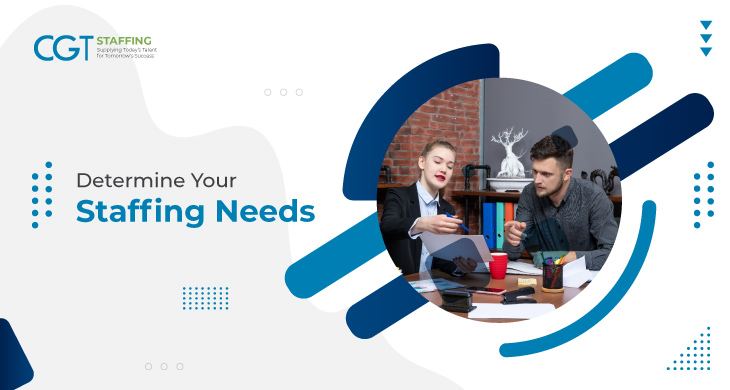Determining the optimal staffing needs for your business is a critical aspect of efficient resource management. Maintaining an adequate number of employees with the necessary skills and expertise ensures smooth operations, productivity, and ultimately, success. Whether you carry out recruiting efforts yourself or through a staffing agency, it can be challenging to strike the right balance between overstaffing and understaffing. For this reason, a knowledgeable staffing partner is always a sensible investment. This blog discusses some valuable tips that can help you determine your staffing needs effectively.
Table of Contents
Evaluate Current Workload
The first step in assessing your staffing requirements is to evaluate your current workload. Analyze the volume and complexity of tasks your team handles on a regular basis. Look for signs of excessive overtime, missed deadlines, or overwhelmed team members. These are surefire indicators that you need additional staff to distribute the workload more efficiently.
Forecast Future Needs
Successful businesses plan for the future. When determining your staffing needs, it’s important to consider your long-term business goals and growth projections. If you anticipate operational expansion or new products or services, you will likely need to increase your resource capacity to support these endeavors. Engage in strategic workforce planning by forecasting your future workforce requirements and aligning your recruitment efforts accordingly. This proactive approach will help you build a capable team that can adapt to the evolving needs of your business.
Analyze Key Performance Indicators (KPIs)
Analyzing key performance indicators (KPIs) aids significantly in assessing your organization’s performance and identifying areas for improvement. Evaluate metrics such as employee productivity, customer satisfaction, and project turnaround time. Such criteria yield valuable insights into areas of the business likely to benefit most from a staffing push. Likewise, they might also indicate areas of the business requiring greater focus and efficiency.
Consider Seasonal and Cyclical Patterns
Many companies experience seasonal or cyclical business fluctuations. It is crucial to consider these patterns when determining your staffing needs. Evaluate historical data to identify peak periods and anticipate any potential slowdowns. By hiring temporary or contract workers and developing a holistic talent acquisition strategy during peak periods, you can ensure adequate staffing levels without incurring unnecessary long-term expenses during slower times.
Conduct Skills Gap Analysis
To ensure that you have people with the right skills in critical roles, conduct a skills gap analysis. Identify the qualifications required for each role within your organization. In conjunction with this analysis, conduct regular performance reviews and encourage open communication with your employees in order to better understand their professional goals. As a whole, such professional reflection will help you to identify whether you need to hire new employees or provide training and development opportunities for your existing staff.
Seek Employee Feedback
Your employees are an invaluable resource when it comes to determining your staffing needs. They are on the front lines and so have a deep understanding of the challenges and bottlenecks within your organization. Encourage a culture of open feedback in which employees can express their concerns, suggest improvements, and share insights on workload distribution.
Moreover, carry out a workplace investigation process when warranted, as an assurance to employees that they can confide in you to seek fair play and resolve conflicts. Regularly seeking employee feedback will help you identify areas where additional staff is required and processes requiring reduction or revision.
Leverage Technology and Automation
In today’s digital age, leveraging technology can significantly streamline your staffing process. Consider implementing an applicant tracking system (ATS) to automate the recruitment and hiring process. An ATS can help you organize candidate resumes, track applications, and optimize communication with potential hires.
Using scheduling software is a further benefit, maximizing employee schedules and ensuring adequate coverage for different shifts or work hours. By utilizing technology effectively, you can save time, reduce administrative burdens, and make informed decisions regarding your staffing needs.
When to Consider Outsourcing or Hiring Temporary Staff
In order to meet your personnel needs, you may consider a staffing agency for outsourcing or hiring temp/contractual workers. Outsourcing certain tasks or projects offers flexibility, cost savings, and access to specialized expertise. Contractors can be an excellent resource for short-term projects or when a personnel flex is required during peak season. Consider the nature of the work and the availability of external resources to determine if any of these is a viable solution for your organization.
Conclusion
Determining your staffing needs is a critical aspect of effective workforce management. By evaluating your current workload, analyzing business cycles, considering future growth, assessing employee skill gaps, leveraging technology, and seeking employee feedback, you can make informed decisions when it comes to hiring and optimizing your workforce.
Striking the right balance between overstaffing and understaffing will not only improve productivity but also contribute to a positive work environment and sustainable business growth. Invest time and effort in assessing your staffing needs regularly to ensure you have the right people in place to achieve your business objectives. Additionally, consider hiring a staffing agency in Pittsburgh to aid you further with your recruiting process and maximizing your exposure to a viable pool of talent.
